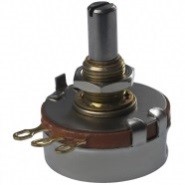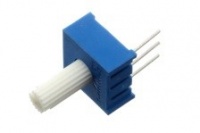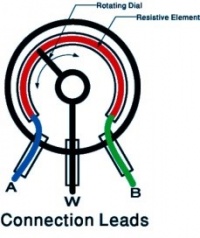Potentiometers
Potentiometers are an electrical device used to measure the position of a shaft or as a simple voltage divider in circuits. A potentiometer is just a variable resistor. If the potentiometer is linear, than the dial will linearly increase its output based on the position of the shaft. The internal setup is very straight forward. The diagram to the top right, shows the potentiometers internal configuration. The red portion is a resistor. Input A would be the voltage source (5V). Input B would be the ground connection. The power and ground connection can be switched to reverse the response from the potentiometer. The red part is a resistive strip. The (W) or wiper is the output. When the knob is turned the wiper can move all the way from ground to the source voltage and anywhere in between. A 10K pot will have a resistance of 10K ohms between the power and source pins.
The most common issues with potentiometers are physical breakage from being overturned or shorting.Shorting happens with a potentiometer when the wiper is connected to source or ground. Potentiometers usually have a maximum voltage and a maximum power. Both rating cannot be exceeded or the resistive strip will be damaged. Some pots are logarithmic but are used far less, usually in sound equipment.


